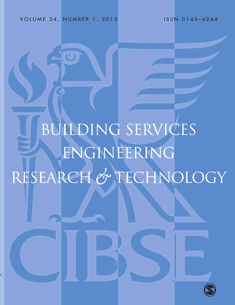
Building Services Engineering Research & Technology
Scope & Guideline
Innovating the Future of Building Services Research
Introduction
Aims and Scopes
- Energy Efficiency and Sustainability:
Research dedicated to improving energy efficiency in buildings, with a strong emphasis on sustainable practices and technologies, including renewable energy integration and energy retrofitting. - HVAC Systems Optimization:
Focuses on optimizing heating, ventilation, and air conditioning (HVAC) systems through advanced modeling, control strategies, and new technologies to enhance performance and indoor air quality. - Thermal Comfort and Indoor Environment:
Investigates various aspects of thermal comfort, indoor air quality, and occupancy behavior to ensure healthy and comfortable environments in residential and commercial spaces. - Fire Safety Engineering:
Explores innovative fire safety solutions, including smoke control systems and evacuation strategies, particularly in complex building designs and urban environments. - Computational Simulations and Modeling:
Utilizes computational fluid dynamics (CFD) and other simulation techniques to assess and predict building performance under various conditions, enhancing design and operational efficiencies. - Digital Technologies and Smart Buildings:
Examines the role of digital twins, IoT, and data-driven methodologies in building management systems to improve operational efficiency and energy management.
Trending and Emerging
- Net Zero and Whole Life Carbon Assessment:
A significant trend is the focus on achieving net-zero emissions in building design and operation, with comprehensive evaluations of whole life carbon impacts becoming a central theme. - Machine Learning and Predictive Control:
Emerging interest in machine learning applications for predictive control of building systems, enhancing energy efficiency and operational performance. - Hybrid and Integrated Systems:
Research is increasingly exploring hybrid systems that combine different technologies (e.g., radiant cooling with fresh air systems) to optimize performance and energy use. - Resilience Against Climate Change:
Studies addressing building resilience against climate change impacts, such as extreme weather events and temperature fluctuations, are gaining traction. - Smart City Applications:
There is a growing emphasis on integrating building services within smart city frameworks, utilizing data-driven approaches to improve urban living conditions. - Advanced Ventilation Strategies:
Innovative ventilation techniques, including hybrid and natural ventilation approaches, are emerging as critical topics in response to indoor air quality concerns, particularly post-COVID-19.
Declining or Waning
- Traditional HVAC Control Systems:
There is a noticeable reduction in research focused on conventional HVAC control systems as newer, more efficient technologies and smart control methodologies gain prominence. - Basic Energy Efficiency Measures:
Basic energy efficiency measures are becoming less of a focus, with more complex and integrated solutions being preferred in recent studies. - General Building Codes and Regulations:
Research centered on general building codes and regulations appears to be waning, possibly due to the increasing emphasis on innovative and flexible approaches to building performance. - Static Fire Safety Measures:
The focus on static fire safety measures is declining, as more dynamic and integrated approaches to fire safety and risk management are being explored.
Similar Journals
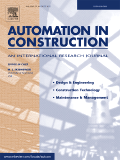
AUTOMATION IN CONSTRUCTION
Driving Efficiency and Innovation in the Construction IndustryAUTOMATION IN CONSTRUCTION is a premier academic journal published by Elsevier, dedicated to advancing the fields of Building and Construction, Civil and Structural Engineering, and Control and Systems Engineering. Since its inception in 1992, this journal has served as a vital platform for disseminating innovative research and practical applications in automation technologies within the construction industry. With a distinguished 2023 impact factor reflected in its Q1 ranking across multiple engineering categories—securing rank #3 in Civil and Structural Engineering and rank #3 in Building and Construction—AUTOMATION IN CONSTRUCTION stands out as a leading resource for researchers, professionals, and students keen on staying at the forefront of this rapidly evolving field. The journal offers access to cutting-edge studies that explore automation processes, methodologies, and tools, contributing to the enhancement of productivity and sustainability in construction practices. With contributions from global experts, each issue of AUTOMATION IN CONSTRUCTION provides comprehensive insights that help drive innovation and foster collaboration.
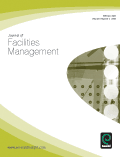
Journal of Facilities Management
Shaping the Landscape of Facilities Management ResearchThe Journal of Facilities Management, published by Emerald Group Publishing Ltd, is a premier scholarly platform dedicated to the evolving field of facilities management. With an ISSN of 1472-5967 and an E-ISSN of 1741-0983, this journal has established itself as a crucial resource for researchers, practitioners, and students alike since its inception. Operating within a robust academic framework, the journal holds a commendable Q2 ranking in various pertinent categories including Business and International Management, Management of Technology and Innovation, and Strategy and Management, reflecting its impact and relevance in these domains. The journal invites high-quality, interdisciplinary research that addresses the complexities of facilities management, providing insights and practical solutions that benefit organizations worldwide. Although not open access, the Journal is committed to maintaining academic rigor and accessible knowledge dissemination through its articles, which are meticulously reviewed by experts in the field. As it continues to evolve through its converged publication years of 2002 to 2003 and 2005 to 2024, the Journal of Facilities Management stands out as an essential resource for those seeking to enhance their understanding and practice of effective facilities management.
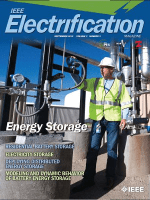
IEEE Electrification Magazine
Navigating the Evolving Landscape of ElectrificationIEEE Electrification Magazine, published by the Institute of Electrical and Electronics Engineers (IEEE), serves as a pivotal platform in the field of Electrical and Electronic Engineering. With an ISSN of 2325-5897 and an E-ISSN of 2325-5889, this esteemed journal aims to bridge the gap between research and practical applications in electrification, addressing current trends and technological advancements since its inception in 2013. Notably recognized as a Q1 journal in Electrical and Electronic Engineering and a Q2 journal in Energy Engineering and Power Technology for 2023, it ranks in the 72nd and 69th percentiles, respectively, within its categories according to Scopus. As a vital resource for researchers, professionals, and students, it delivers thought-provoking articles that stimulate discourse and innovation within the electrification landscape, though it currently does not offer open access. The editorial excellence and rigorous peer-review process ensure that each published piece contributes meaningfully to the dynamic field of electrification, solidifying the journal’s importance as a leading voice in advancing engineering practices and education.

Engineering Reports
Fostering innovation in engineering with open-access insights.Engineering Reports is a premier open-access journal published by Wiley, dedicated to advancing the fields of Engineering and Computer Science. Since its inception in 2019, this journal has rapidly gained recognition, achieving a commendable Q2 ranking in both the engineering and computer science categories in 2023, evidencing its impactful contributions to the scientific community. With an impressive Scopus rank of #70/307 in General Engineering and #63/232 in General Computer Science, the journal is well-positioned to disseminate cutting-edge research and foster innovation. Researchers, professionals, and students will find value in its comprehensive scope, which includes emerging technologies and interdisciplinary studies, making it an essential resource for anyone involved in these dynamic fields. Accessible online, Engineering Reports aims to bridge the gap between complex engineering theories and practical applications, enhancing collaboration and knowledge sharing globally.

International Journal of Ventilation
Transforming Knowledge into Sustainable PracticesThe International Journal of Ventilation, published by Taylor & Francis Ltd, serves as a critical platform for the dissemination of innovative research in the fields of building and construction, civil and structural engineering, control and systems engineering, and electrical and electronic engineering. With an ISSN of 1473-3315 and an e-ISSN of 2044-4044, this esteemed journal has maintained a significant presence since its inception in 2005 and continues to provide valuable insights for academics and professionals alike until 2024. Recognized in the 2023 rankings, it holds a Q2 designation in Building and Construction and Q3 status in several other engineering categories, reflecting its solid standing in the academic community. Despite its non-open access format, the journal remains a vital resource, focusing on advanced ventilation solutions that shape sustainable practices in building design and engineering systems. By publishing high-quality peer-reviewed articles, the International Journal of Ventilation plays a pivotal role in advancing knowledge, fostering collaboration, and inspiring future research within its dynamic fields of study.
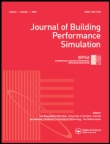
Journal of Building Performance Simulation
Pioneering Research for a Sustainable Built EnvironmentJournal of Building Performance Simulation, published by Taylor & Francis Ltd, is a premier academic journal dedicated to advancing the fields of architecture, building and construction, and computational modeling. With an ISSN of 1940-1493 and an E-ISSN of 1940-1507, this journal is recognized for its high-quality, peer-reviewed research, reflected in its impressive Q1 ranking in both Architecture and Building and Construction categories for 2023. Spread over a notable converged publishing timeline from 2008 to 2024, it aims to address contemporary issues in building performance and simulation methodologies, serving both practitioners and academics alike. Positioned within the 92nd percentile in Engineering - Architecture, the journal is a vital resource for professionals focused on innovative design and simulation technologies that enhance building efficiency and sustainability. Despite its robust reputation, the journal currently does not offer open-access options, which underscores its commitment to maintaining academic rigor. Engage with cutting-edge research that drives the future of building performance through this influential journal.
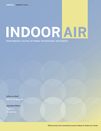
INDOOR AIR
Transforming Spaces, Enhancing Lives.INDOOR AIR is a leading peer-reviewed journal published by WILEY-HINDAWI, focusing on the critical field of indoor environmental quality and its impact on public health. Since its inception in 1991, this esteemed journal has been at the forefront of research in Building and Construction, Environmental Engineering, and Public Health. With a commendable Q1 ranking across these categories in 2023, INDOOR AIR has established itself as a pivotal resource for scholars and industry professionals alike, as evidenced by its impressive Scopus rankings—35th in Public Health, 14th in Building and Construction, and 20th in Environmental Engineering. The journal is dedicated to disseminating groundbreaking research, reviews, and case studies that advance knowledge and methodologies in improving indoor air quality and its implications for health outcomes. Aspiring to maintain open access to vital scientific discourse, INDOOR AIR invites contributions that foster interdisciplinary collaboration and innovation in understanding indoor environments. Based in Denmark, the journal continues to engage a global audience committed to enhancing health and well-being through improved indoor air quality.

Journal of Architectural Engineering
Connecting Theory and Practice in Architectural EngineeringThe Journal of Architectural Engineering, published by the ASCE (American Society of Civil Engineers), stands as a pivotal resource in the interdisciplinary fields of architecture and engineering. With an ISSN of 1076-0431 and E-ISSN 1943-5568, this journal has garnered a notable reputation since its inception in 1995, currently converging towards 2024. Boasting a Q1 ranking in Architecture and Visual Arts and Performing Arts, alongside respectable Q3 rankings in Building and Construction and Civil and Structural Engineering, the journal places itself in the elite class of scholarly publications, evidenced by its impressive Scopus rankings. Its commitment to providing cutting-edge research ensures comprehensive coverage across various aspects of architectural engineering, facilitating robust interdisciplinary dialogues. Although the journal operates under a traditional access model, its impact on the academic community remains profound, making it an essential platform for researchers, professionals, and students who seek to push the boundaries of knowledge in their respective fields. This journal not only aims to stimulate innovative ideas but also fosters a collaborative environment for advancing sustainable architectural practices in a rapidly evolving built environment.

Russian Journal of Building Construction and Architecture
Pioneering Research for Tomorrow's Architectural ChallengesRussian Journal of Building Construction and Architecture (ISSN: 2542-0526; E-ISSN: 2542-0526), published by the esteemed Voronezh State Technical University, serves as a vital platform for disseminating innovative research and practical applications in the fields of building construction and architecture. This journal, situated in Voronezh, Russia, aims to explore both the theoretical and empirical aspects of contemporary architecture and construction practices, fostering a robust dialogue among researchers, professionals, and academics. With an emphasis on open access to knowledge, the journal significantly contributes to global discourse by ensuring that findings are accessible to a wide audience. Underlining the importance of sustainable development and cutting-edge technologies in construction, the journal strives to publish high-quality research that addresses the challenges faced in today’s building environment, making it an invaluable resource for those committed to advancing the industry.
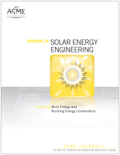
JOURNAL OF SOLAR ENERGY ENGINEERING-TRANSACTIONS OF THE ASME
Empowering Innovation in Solar Energy Engineering.JOURNAL OF SOLAR ENERGY ENGINEERING-TRANSACTIONS OF THE ASME is a premier publication dedicated to advancing the field of solar energy engineering, under the auspices of the prestigious American Society of Mechanical Engineers (ASME). With the ISSN 0199-6231 and E-ISSN 1528-8986, this journal has established itself as a critical resource for researchers and professionals alike, particularly in the areas of energy engineering and renewable technology. Currently enjoying an impact factor that places it in the Q2 category for Energy Engineering and Power Technology and Q3 for Renewable Energy, Sustainability, and the Environment, this journal effectively bridges impactful research and practical application. Spanning contributions from 1980 to 2025, the journal emphasizes empirical studies, innovative methodologies, and sustainable solutions that resonate with the growing global demand for renewable energy. The journal’s commitment to quality is reflected in its competitive Scopus rankings: 97th out of 272 in Energy Engineering and 124th out of 270 in Renewable Energy. Although not an Open Access journal, it remains a vital forum for disseminating research that shapes our energy future. Located in New York, this journal serves as a cornerstone for those in academia and industry to stay abreast of the latest advancements in solar energy technologies and their application in sustainable development.